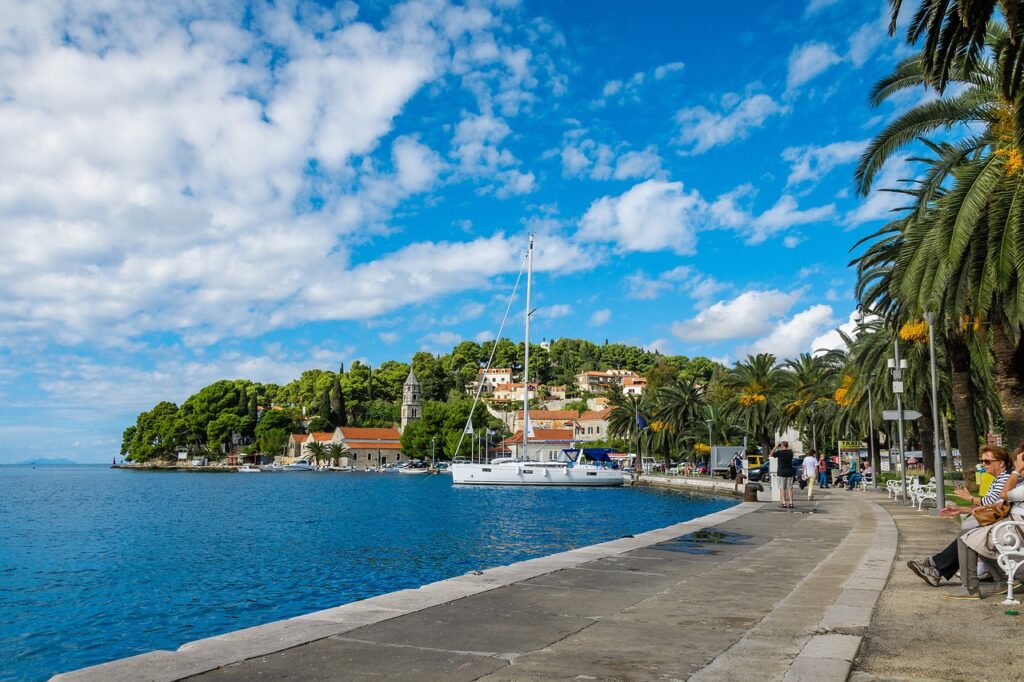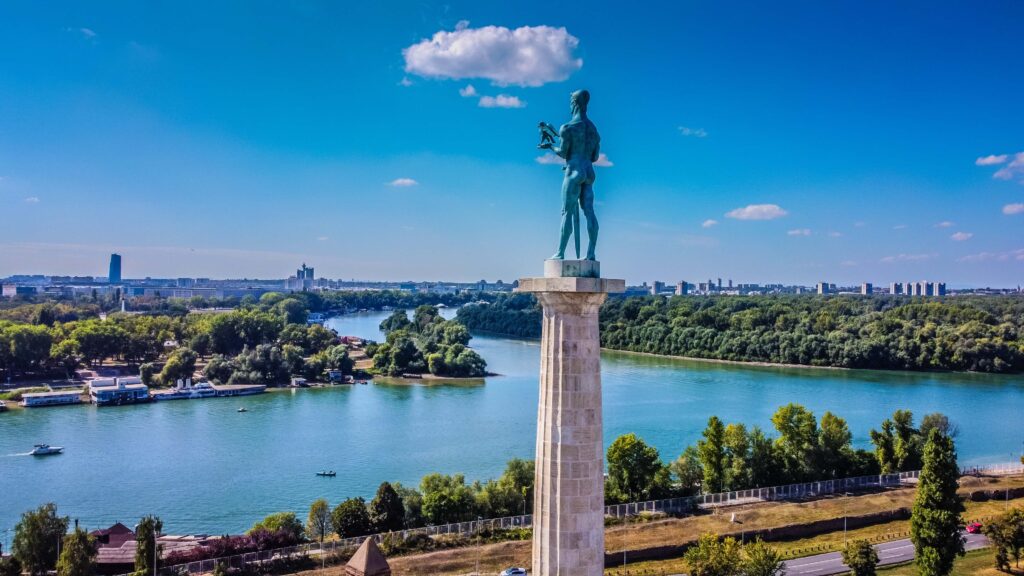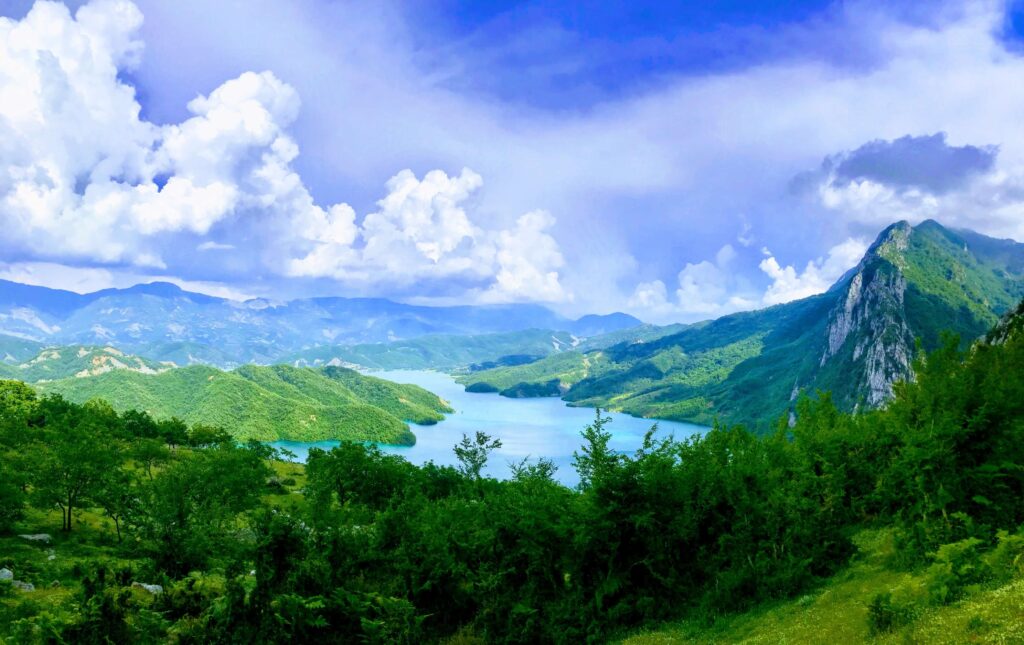Dubrovnik, with its ancient walls and bustling streets, is undoubtedly a must-visit destination in Croatia. But just 20 kilometres south lies a hidden gem that often gets overlooked: Cavtat.
This charming coastal town offers a quieter, more authentic experience, making it the perfect escape from Dubrovnik’s crowds. Here’s your guide to discovering the best of Cavtat, including all the best beaches, restaurants and outdoor activities.
*This post contains affiliate links, which are included to provide easy access to products or services we genuinely recommend. We may make a small commission if you make a purchase or booking through one of these links. This comes at no extra cost to you, but helps to sustain our site and create more valuable content.*
How to Get to Cavtat from Dubrovnik
If you’re planning a day trip from Dubrovnik to Cavtat, you can travel by road or water. Regular buses run from Dubrovnik’s main bus station and take about thirty minutes to reach Cavtat; the number 10 runs at least once an hour during high season, and tickets cost a few euros.
You can also take a taxi, although this will be more expensive. If you would prefer the freedom to explore the region independently, platforms such as Discover Cars and Qeeq offer car rentals. You can pick up cars from Dubrovnik, or from the airport when you arrive.
You can also get from Dubrovnik to Cavtat by boat. Travelling by boat to Cavtat is great during summer, as the ride is particularly scenic and you won’t have to deal with traffic. Boats depart from Dubrovnik’s Old Port multiple times a day during high season. However, the journey time is longer than travelling by bus, taking from 45 minutes to an hour, and prices can be as much as twenty euros for a return ticket.
Top Things to Do and See in Cavtat
As the centre of the Konavle region, Cavtat offers plenty to do and see. The most popular options revolve around exploring the outdoors and taking advantage of the fact that Cavtat is less touristy than nearby Dubrovnik.
Cavtat’s Cultural Heritage
Cavtat’s Old Town, with its narrow cobblestone streets and stairs lined with centuries-old stone houses, transports you back through the centuries. It may be much (much) smaller than Dubrovnik’s, but makes up for what it lacks in size in authenticity. Don’t miss the St. Nicolas Church or the nearby Shell Museum, a hidden gem.
You can also visit the Bukovac House Museum. Born and raised in Cavtat, the renowned painter Vlaho Bukovac (1855–1922) left an indelible mark on the art world. The house where he was born now houses a museum dedicated to his works.
Furthermore, Croatia’s most renowned sculptor, Ivan Meštrović, also left his mark in Cavtat. The Račić family mausoleum, built with high-quality Brač stone, stands majestically in the Saint Rocco Cemetery on the Rat Peninsula.
Beaches
Cavtat boasts several pebble beaches, where you can swim in crystal-clear waters or sunbathe with views of the Adriatic Sea. The beaches are generally less crowded than Dubrovnik, making them better for families or anyone looking for a bit of peace and quiet. Bear in mind that they’ll still be pretty busy on weekends or during peak season (July and August).
While Cavtat Beach is the most popular and offers plenty of amenities, and Tiha Bay is known for being one of the few beaches with sand, we recommend checking out some of Cavtat’s other options. Consider the following:
Sustjepan Beach
Located on the peninsula of the same name, Sustjepan Beach offers a fantastic view of the picturesque port. This well-kept concrete beach provides easy access to the crystal-clear waters, and is ideal for snorkelling.
You can rent sunshades and beach chairs here, and kayaks are available for those seeking a little adventure. There’s also a cool beach bar that offers refreshing drinks and stunning vistas.
Žal Beach
Situated in the northern part of Cavtat, Žal Beach is loved by families. Its fine pebble shoreline transitions into a sandy seabed, making it ideal for barefoot bathing. Several restaurants, bars, and snack spots ensure you won’t go hungry during your beach day, or you can bring a picnic if you’re on a budget.
Kids (and the young at heart) can enjoy a water bouncy castle, while a water sports centre offers kayaks, pedal boats, and paddle board rentals.
Rat Beach
Hidden on the wooded Rat Peninsula, just north of the port and town centre, Rat Beach offers a unique blend of green, shady pine forests and turquoise sea. It’s one of the smaller and more secluded beaches in a Cavtat, and is great for a quiet morning swim.
The beach features a mix of rocky and pebbled areas, making it suitable for families, and the gentle entrance into the sea ensures safe swimming.
Water Sports
Cavtat is a great location for water sports, offering advanced as well as beginner and family friendly options. As mentioned above, Žal Beach has a water bouncy castle and is one of many locations to offer equipment rentals. Kayaks, pedal boats and paddle boards are the most popular options, and you can often get group or family discounts.
If you’re looking for more of an adrenaline rush, you can also find speedboat and jet ski rentals in the area, as well as parasailing and scuba diving tours for certified divers. Get Your Guide offers reliable booking options for adventure activities in Cavtat and the wider region.
Hiking and Cycling
Cavtat has some great nature trails, and no matter the time of year, they’ll be much less crowded than the popular Mount Srđ trail in Dubrovnik. You can hike or cycle, but remember to bring water, as well as a hat, sunscreen and snacks during summer.
Popular routes include the following:
- Cavtat Seaside Promenade
- The main Cavtat walk stretches approximately 8 kilometres along the shore. Starting from the south beach of Hotel Croatia, it winds around the untouched Sustjepan Peninsula, passes the famous Cavtat Promenade, and continues to Rat Peninsula.
- Cavtat to Epidaurum
- Archaology enthusiasts shouldn’t miss the 3 mile journey (with an elevation gain of over 200 feet) to the remnants of the ancient Greek colony of Epidaurum, which once thrived in the area.
- Cavtat to Čilipi
- The Cavtat to Čilipi footpath covers approximately 5 miles with an elevation gain of over 800 feet, taking you through charming villages, rolling hills, and lush greenery.
- Cavtat to Velji Do from Hotel Croatia
- For a more extended adventure, consider the 11 mile hike to the small village of Velji Do. With an elevation gain of 2000 feet, the trail offers breathtaking views of the Adriatic and diverse terrain, from coastal paths to forested sections.

Boat Trips
There are plenty of islands in the region, and Cavtat is a great place from which to explore them. You can either take a water taxi to Dubrovnik and join one of the many boat tours from the Old Port, or you can hire a private boat from Cavtat and head straight to your desired location.
Popular destinations for boat trips include Lokrum, located just fifteen minutes off the coast of Dubrovnik, as well as the Elaphiti Islands. You could also go slightly further to Korčula and the Pelješac Peninsula, which are renowned for their vineyards and wineries.
If you’d like to explore one of Croatia’s eight national parks, Mljet Island is home to Mljet National Park. It’s the closest and most accessible if you’re based in Cavtat, and private boat trips offer the opportunity to make the most of the park.
If you’re interested in boat trips from Cavtat but can’t decide where to go, the following articles may be useful:
- Everything You Need to Know About Lokrum Island
- Best Activities and Attractions on Lokrum Island
- Dubrovnik to Mljet: How to Visit Mljet National Park on a Day Trip from Dubrovnik
The article about Mljet is geared towards those taking day trips from Dubrovnik, but still provides plenty of information about Mljet National Park. It will be particularly useful if you’re based in Cavtat, but are interested in travelling to Dubrovnik in order to have a bigger range of options for guided tours.
Local Gastronomy
Cavtat’s gastronomical scene is definitely worth exploring, offering regional wines and a blend of Mediterranean and traditional Croatian flavours. Make sure to try the following:
- Fresh Fish: From grilled sea bass to octopus salad, Cavtat’s seafood offerings are exceptional. Don’t miss the catch of the day prepared with local herbs and olive oil.
- Vegetables and Olive Oil: Mediterranean cuisine shines through dishes like sautéed Swiss chard, eggplant moussaka, and zucchini fritters. Pair them with the finest local olive oils.
- Peka: A traditional slow-cooked dish made with lamb or veal, potatoes, and vegetables. It’s baked under a bell-shaped lid, resulting in tender, flavourful meat.
- Smoked Ham and Cheese: Try the local smoked ham and aged cheeses, often served with olives and homemade bread.
Cavtat and the wider Konavle region are home to vineyards producing both international and indigenous grape varieties. Look out for Dubrovnik Malvasia Blanc, an autochthonous white wine with floral and fruity notes, Plavac Mali, a robust red wine known for its rich flavour and hints of dark berries, and Kadarun, a lesser-known grape variety producing elegant red wines. Wine tastings and vineyard tours are also available.
There are many notable restaurants and wine bars in Cavtat, offering sea views, fresh seafood and Croatian specialities. Some of the most popular include Bugenvila, Dalmatino, Ivan Restaurant and La Boheme, all of which offer diverse menus and outdoor seating.
In terms of price range, mid-range restaurants like Dalmatino and Ivan offer a balance of quality and value, while Bugenvila and La Bohème offer fine dining. You can also find budget-friendly options at smaller cafes and bistros in the area (usually the further back from the promenade, the more affordable they are).
Accommodation Options in Cavtat
There’s a wide range of Cavtat accommodation options, from luxurious five-star and all-inclusive hotels to budget apartment rentals. Prices are highest in July and August, but you’ll still usually find cheaper and better value than you would in Dubrovnik.
Some of the most popular stays (in no particular order) are Hotel Croatia, Hotel Cavtat, Remisens Hotel Albatros, Boutique B&B Villa Faggioni and Hotel Supetar. Lookout for perks such as direct beach access and personalised service.
Best Time to Visit Cavtat
The shoulder seasons of Spring and Autumn are the best times to visit Cavtat. In Spring (from April to June) the weather is pleasant, with blooming flowers and temperatures warm enough to enjoy the outdoors without risking sunburn or heatstroke.
Hiking and cycling are the most popular options as well as strolls along the promenade and picnics on the beaches. However, usually you’ll have to wait until the end of May if you want to try water activities, as this is when the sea will be warm enough.
The summer months of July and August are the most popular time to visit Cavtat, and therefore the most crowded and expensive. Expect to pay more for accommodation, food and activities, and make sure you book accommodation in advance.
Autumn (mid-September to the end of October) is also a good time to visit. Temperatures are mild, slowly decreasing from the mid-20s to the late teens (degrees Celsius). September is perfect for swimming as the beaches will be far less crowded, although it’s usually too cold in October.
If you’re at a hotel with a heated pool, swimming should be fine on warmer days. Autumn is also great because tourist season is winding down, and prices start to come down for winter.
If you don’t mind cold weather, you can save money by visiting over winter. This is the perfect time to take advantage of low visitor numbers, although many restaurants and shops may be closed. However, if you’re more interested in cultural heritage and the history of the region, Cavtat is a peaceful base for exploring the area.
Reasons to Choose Cavtat Over Dubrovnik
- Peace and Tranquillity: Cavtat offers a slower pace of life, perfect for relaxation. While there are still bars and affordable accommodation options, the fact it’s situated 20km from the centre of Dubrovnik mean that you’ll be able to avoid the students and backpacking crowds.
- Authenticity: Experience local culture and traditions away from the tourist hustle and bustle- you’re far less likely to get ripped off in Cavtat, and can also avoid the Game of Thrones fans!
- Natural Beauty: Cavtat’s stunning coastal views, lush greenery, and pristine beaches are unspoiled by mass footfall. There are still plenty of equipment rental spots if you’re interested in an active holiday, and you’ll save a few euros in comparison to Dubrovnik prices.
- Convenience: Cavtat is actually closer to Dubrovnik Airport than the city itself, located just ten minutes away. This makes it more convenient to reach if you’re planning on visiting the region, but want to avoid the crowds.
Whether you’re considering day trips from Dubrovnik or would like the advantages of being near a city but prefer staying somewhere more peaceful- maybe you’ve just found an incredible deal on flights to Dubrovnik, but aren’t sure about spending your downtime in a big city- Cavtat is a fantastic option.
So, next time you’re in Dubrovnik, consider a day trip or even an extended stay in Cavtat. Remember, the best-kept secrets are the ones most worth exploring.
CTA: Check out Kiwi for flight deals to Dubrovnik airport, located just ten minutes from Cavtat!



